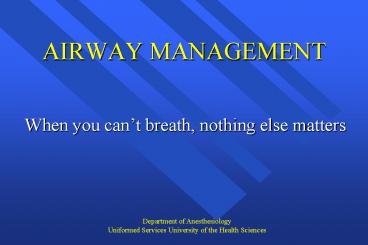AIRWAY MANAGEMENT - PowerPoint PPT Presentation
1 / 23
Title:
AIRWAY MANAGEMENT
Description:
Safe and Common Practice in Patients Undergoing General Anesthesia ... Alternatives To Orotracheal Intubation Under Anesthesia. Awake Orotracheal Intubation ... – PowerPoint PPT presentation
Number of Views:237
Avg rating:3.0/5.0
Title: AIRWAY MANAGEMENT
1
AIRWAY MANAGEMENT
- When you cant breath, nothing else matters
Department of Anesthesiology Uniformed Services
University of the Health Sciences
2
Establishing A Patent Airway
- Chin Lift and Jaw Thrust Maneuver
- Oropharyngeal Airway
- Nasopharyngeal Airway
- Laryngeal Mask Airway
- - The above do not protect against aspiration and
laryngospasm
Department of Anesthesiology Uniformed Services
University of the Health Sciences
3
Mask Ventilation
- Can Deliver A High FIO2
- Avoids The Potential Trauma Of Intubation
- Does Not Protect Against Aspiration
- May Result In Gastric Distension
- Laryngospasm Can Occur
- Requires Use Of Both Hands
Department of Anesthesiology Uniformed Services
University of the Health Sciences
4
Oral/Nasal Intubation
- Safe and Common Practice in Patients Undergoing
General Anesthesia - Atraumatic Intubation requires Knowledge of
Anatomy, Appropriate use of Equipment, and Drugs
(Muscle Relaxants)
Department of Anesthesiology Uniformed Services
University of the Health Sciences
5
Preoperative Evaluation
- Patient History
- - Prior History of Difficult Intubation
- - Tumor of Head and Neck
- - Arthritis
- - Pregnancy
- - Trauma - C Spine, Full Stomach
Department of Anesthesiology Uniformed Services
University of the Health Sciences
6
Preoperative Evaluation
- Physical Examination
- - Tongue versus Pharyngeal Size
- - Atlanto - Occipital Joint Extension
- Cervical Spine Mobility (normal 35 degrees)
- - Anterior Mandibular Space
- Thyromental distance - normal is 6 cm
- - Dental Examination (Loose Teeth, Prostheses)
Department of Anesthesiology Uniformed Services
University of the Health Sciences
7
Department of Anesthesiology Uniformed Services
University of the Health Sciences
8
Department of Anesthesiology Uniformed Services
University of the Health Sciences
9
Department of Anesthesiology Uniformed Services
University of the Health Sciences
10
Technique For Orotracheal Intubation
- Preparation And Equipment (Always Have Suction
Available) - Head Position - Alignment Of Oral, Pharyngeal,
and Laryngeal Axes - Choice Of Laryngoscope And Endotracheal Tube
- Possible Need For Awake Tracheal Intubation
- - Difficult Airway Algorithm
Department of Anesthesiology Uniformed Services
University of the Health Sciences
11
Department of Anesthesiology Uniformed Services
University of the Health Sciences
12
Orotracheal Intubation
- Patients Head At The Level Of The Xiphoid
- Sniffing Position
- Laryngoscope In LEFT Hand
- Open Mouth
- Hold Tracheal Tube In Right Hand Like A Pencil
Department of Anesthesiology Uniformed Services
University of the Health Sciences
13
Department of Anesthesiology Uniformed Services
University of the Health Sciences
14
Department of Anesthesiology Uniformed Services
University of the Health Sciences
15
Department of Anesthesiology Uniformed Services
University of the Health Sciences
16
Department of Anesthesiology Uniformed Services
University of the Health Sciences
17
Department of Anesthesiology Uniformed Services
University of the Health Sciences
18
Department of Anesthesiology Uniformed Services
University of the Health Sciences
19
Complications Of Orotracheal Intubation (During)
- Dental And Oral Soft tissue Trauma
- Hypertension And Tachycardia
- Cardiac Dysrhythmias And Myocardial Ischemia
- Aspiration
- Corneal Damage
Department of Anesthesiology Uniformed Services
University of the Health Sciences
20
Complications Of Orotracheal Intubation
(Intubated Patient)
- Tracheal Tube Obstruction
- Endobronchial Intubation
- Barotrauma
- Accidental Disconnect
- Tracheal Mucosa Ischemia
- Accidental Extubation
Department of Anesthesiology Uniformed Services
University of the Health Sciences
21
Immediate And delayed Complications On Extubation
- Laryngospasm
- Aspiration
- Pharyngitis
- Laryngeal Or Subglottic Edema
- Vocal Cord Paralysis
- Arytenoid Cartilage Dislocation
Department of Anesthesiology Uniformed Services
University of the Health Sciences
22
Alternatives To Orotracheal Intubation Under
Anesthesia
- Awake Orotracheal Intubation
- Nasotracheal Intubation
- - Awake Blind Nasal
- - Nasotracheal Intubation After Induction
- Intubation With Fiberoptic Bronchoscope
- - Awake versus Under Anesthesia
- - Orotracheal versus Nasotracheal
- Retrograde Intubation
Department of Anesthesiology Uniformed Services
University of the Health Sciences
23
Verification Of Correct Tube Placement
- Symmetric Chest Movement
- Symmetric Breath Sounds
- End tidal Carbon Dioxide
- - Greater Than 30 For 3-5 Breaths
- Condensation Of Water In The tube
- Palpation Of Cuff In Suprasternal Notch
- Fiberoptic Bronchoscopy
Department of Anesthesiology Uniformed Services
University of the Health Sciences































